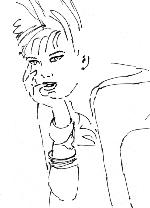| home
l domestic
violence | rape
and sexual abuse | harassment
| prostitution
| homosexuals |
birth
control and abortion | |
| The cycles of violence (5/11) | |
|
| |
|
Domestic violence develops through cycles whose intensity and frequency increase with time. Indeed, periods of escalating tension occur in a context of domestic violence, generally starting with psychological aggression: denigration of what a woman is, of what she says and does. Then the verbal violence starts. This is the step that often precedes physical aggression. During the entire escalation phase, the woman is going to display force and take extraordinary measures to maintain balance in the situation. She can deny what she feels in an attempt to master the fear and to give herself the impression that she can still control the situation, especially if she has already lived through several cycles of violence. |
|
|
If you need to consult a doctor, Ask
for a " certificat d'incapacité even if you don't have |
The explosive phase of the violence can seem to be characterized by the total loss of control of the violent partner and can occur over the smallest detail or excuse. In realise, this loss of control is an efficient way to terrorize the other person. This phase is the shortest and the end of the violent outburst seems tied to the physical and emotional exhaustion of the aggressor or the victim (the aggressor feels like' "she understands now"). During this
period, the woman is terrorised, can attempt to defend herself or look
for a place to take cover. Following this violent episode, in a state
of shock, she will sometimes need to see a doctor due to more or less
serious physical wounds. Even if there are no bodily injuries, she might feel
a diffused uneasiness in reaction to this attack. |
|
A period of remission takes place after this crisis. The spouse has a tendency to regret what he did and to want to be forgiven: fearing the loss of his partner, he minimizes the facts, justifies his behaviour by blaming outside factors, and promises to never do it again. The woman then considers herself partly responsible for what just happened. |
|
|
This description of the cycles |
This attitude gives the woman hope that he'll change, that he won't be violent anymore if she meets his needs, if she is able to help him and support him. The couple is going to launch into a period said to be "second honeymoon": the woman rediscovers a calm and attentive partner. This is what encourages her to stay or to start living together again, to erase from her thoughts the horrible scenes that she has lived. But the more often the cycle repeats itself, the hold of violence on the victim becomes stronger and the periods of "second honeymoons" are reduced. The woman might then be exposed daily to contempt, to control, to attacks, living in fear, insecurity, adjusting herself to the needs of her partner, focusing on his moods. The woman will perceive herself incompetent in her couple and elsewhere, she will feel responsible for the partner's violence. Devalued, she well feel incapable of getting out or improving her situation. |
| home
l domestic
violence | rape
and sexual abuse | harassment
| prostitution
| homosexuals |
birth
control and abortion | |


